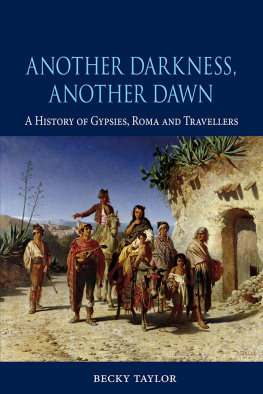CONTENTS

Anton Weiss-Wendt
Chapter 1
Assimilation and Persecution: An Overview of Attitudes toward Gypsies in France
Shannon L. Fogg
Chapter 2
Genocidal Trajectory: Persecution of Gypsies in Austria, 19381945
Florian Freund
Chapter 3
Ustaa Mass Violence Against Gypsies in Croatia, 19411942
Alexander Korb
Chapter 4
Ethnic Cleansing or Crime Prevention? Deportation of Romanian Roma
Vladimir Solonari
Chapter 5
Nazi Occupation Policies and the Mass Murder of the Roma in Ukraine
Mikhail Tyaglyy
Chapter 6
The Nazi Persecution of Roma in Northwestern Russia: The Operational Area of the Army Group North, 19411944
Martin Holler
Chapter 7
The Justice System of the Federal Republic of Germany and the Nazi Persecution of the Gypsies
Gilad Margalit
Chapter 8
Disentangling the Hierarchy of Victimhood: Commemorating Sinti and Roma and Jews in Germanys National Narrative
Nadine Blumer
Chapter 9
The Aftermath of the Roma Genocide: From Implicit Memories to Commemoration
Sawomir Kapralski
First published in 2013 by
Berghahn Books
www.berghahnbooks.com
2013, 2015 Anton Weiss-Wendt
First paperback edition published in 2015.
All rights reserved.
Except for the quotation of short passages for the purposes of criticism and review, no part of this book may be reproduced in any form or by any means, electronic or mechanical, including photocopying, recording, or any information storage and retrieval system now known or to be invented, without written permission of the publisher.
Library of Congress Cataloging-in-Publication Data
The Nazi genocide of the Roma : reassessment and commemoration ; edited by Anton Weiss-Wendt.
pages cm. (Studies on war and genocide ; volume 17)
Includes bibliographical references and index.
ISBN 978-0-85745-842-1 (hardback : alk. paper) ISBN 978-1-78238-923-1 (paperback : alk. paper) ISBN 978-0-85745-843-8 (ebook)
1. RomaniesNazi persecutionCongresses. 2. World War, 19391945AtrocitiesCongresses. 3. RomaniesGermanyHistory20th centuryCongresses. 4. GermanyEthnic relationsCongresses. I. Weiss-Wendt, Anton, 1973 editor of compilation.
D804.5.G85N39 2013
940.531808991497dc23
2012037868
British Library Cataloguing in Publication Data
A catalogue record for this book is available from the British Library.
Printed on acid-free paper.
ISBN: 9780-857458421 hardback
ISBN: 978-1-78238-923-1 paperback
ISBN: 9780-857458438 ebook
To Michael Zimmerman (19512007), historian and humanitarian
War and Genocide
General Editors: Omer Bartov, Brown University; A. Dirk Moses, European University Institute, Florence, Italy/University of Sydney
There has been a growing interest in the study of war and genocide, not from a traditional military history perspective, but within the framework of social and cultural history. This series offers a forum for scholarly works that reflect these new approaches.
The Berghahn series Studies on War and Genocide has immeasurably enriched the English-language scholarship available to scholars and students of genocide and, in particular, the Holocaust.Totalitarian Movements and Political Religions
For a full volume listing, please see back matter
THE NAZI GENOCIDE OF THE ROMA
THE NAZI GENOCIDE OF THE ROMA
Reassessment and Commemoration
Edited by
Anton Weiss-Wendt

ACKNOWLEDGMENTS

I want to acknowledge several individuals who have been very helpful at the earlier stage of this book project: Charles Westin and Mats Deland of Stockholm University, and Joackim Scheele and Oscar sterberg of Living History Forum. A special thank you goes to Winfried Etzel, who has translated from German Florian Freunds chapter, and Samantha Fox, who has copyedited several chapters in this volume. I also thank my colleagues at the Center for the Study of the Holocaust and Religious Minorities in Oslo who have lent their full support to this book project. Finally, I want to express my gratitude to the editorial staff of Berghahn Books and the two anonymous readers whose pointed comments have helped to improve the overall quality of the manuscript.
More than anyone else, however, this volume owes to the late Michael Zimmermann, the scholar who has perhaps contributed most to the study of the Nazi genocide of the Roma. Published in 1996, his magisterial work Rassenutopie und Genozid. Die nationalsozialistische Lsung der Zigeunerfrage remains the most comprehensive account to date. Based on the broadest possible reading of sources, Zimmermanns analysis struck an effective balance between the Intentionalist and Functionalist interpretations. Zimmermann was also the first to make a comparison between Nazi and Soviet policies toward the Roma in the 1930s. Zimmermann advanced research in his capacity as a founding member of the Sinti and Roma working group at the Fritz Bauer Institute in Frankfurt am Main and the co-editor of Romani Studies. Beside his mastery of sources and ability to contextualize, Zimmermann has projected a certain sense of humanity. Unlike many other scholars, Zimmermann exhibited compassion toward the victims in whose name he has carried out research, without either succumbing to social activism or lowering the standards of historical inquiry. He was articulate in his writings and soft-spoken in real life. His premature death in early 2007 not only impoverished the academic community but also left the Roma people without one of its champions. This collection of essays is dedicated to his memory and the cause of humanity that he has pursued throughout his career as a historian.
INTRODUCTION
Anton Weiss-Wendt

This volume uses the framework of genocide to analyze the patterns of persecution of the Roma in Nazi-dominated Europe. The new archival evidence presented in this anthology confirms the earlier findings that placed the victimization of the Roma within the definition of genocide. Without departing from the actual wording of the UN Genocide Convention, the contemporary legal practice in establishing criminal intent suggests a common design that rendered the comprehensive destruction of the Roma communities unequivocally genocidal. Naturally, the extent and means of persecution varied from country to country and the differences sometimes overruled commonalities. The context in which the process of destruction evolved, however, invites certain generalizations.
Due to the lack of reliable statistics on the size of prewar Romani population for each country and Europe as a whole, the estimates of the death toll vary greatly, from 96,000 to 500,000, with the likely figure in excess of 200,000. Following the years of conventional and legal discrimination instituted in Nazi Germany, but also in other European countries, the invasion of the Soviet Union in 1941 provided for a radical solution of the Gypsy Question. The








